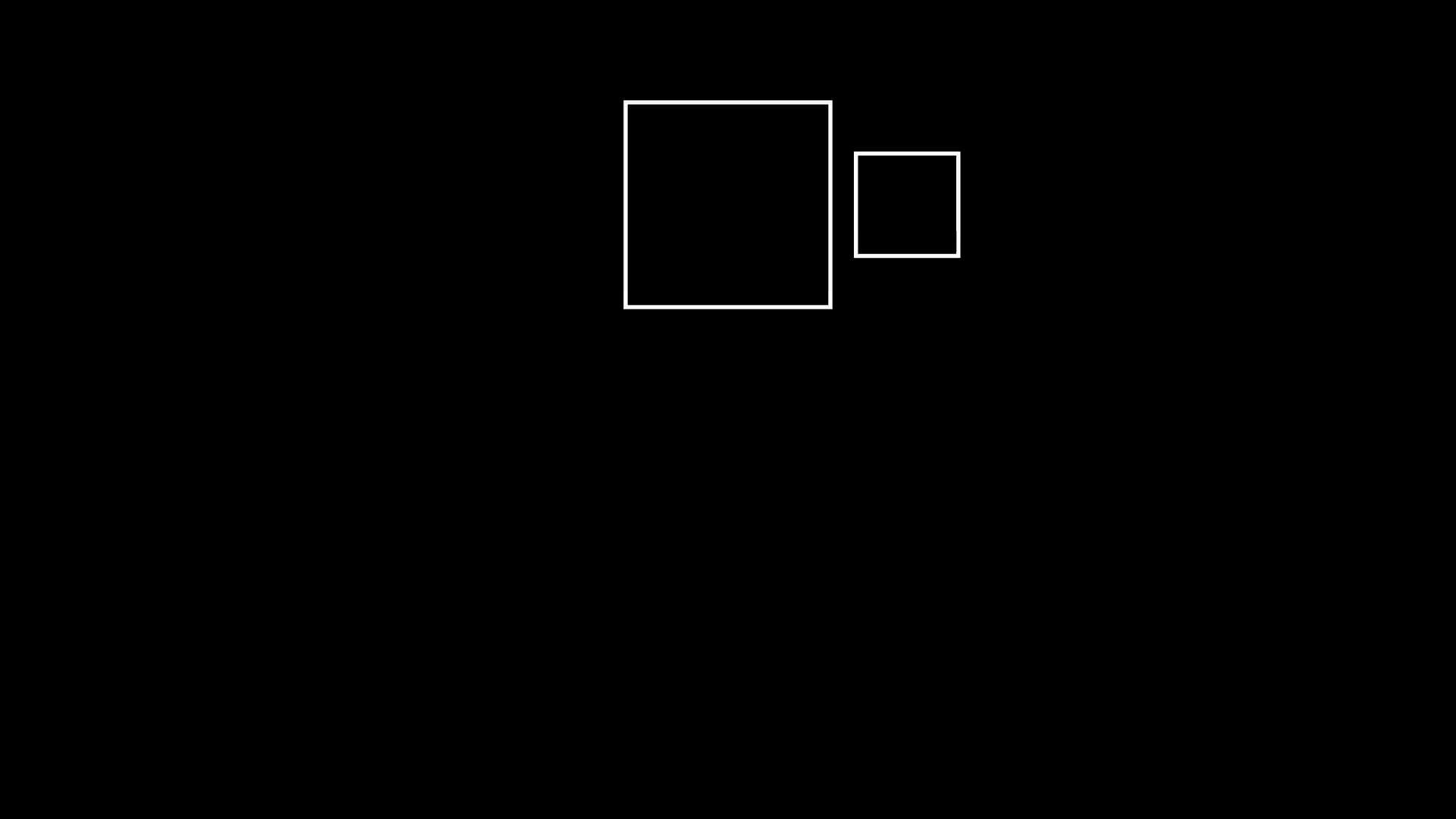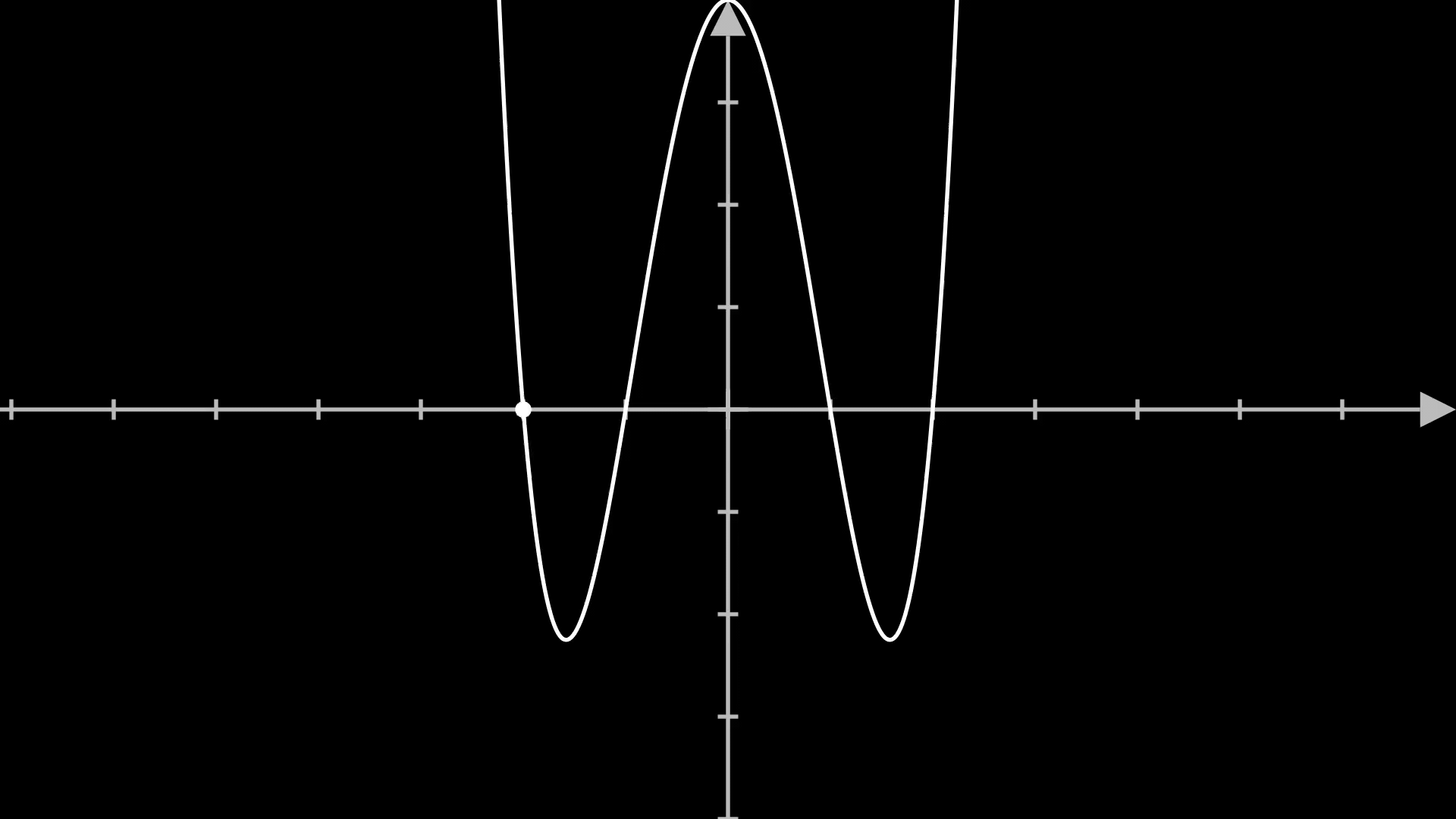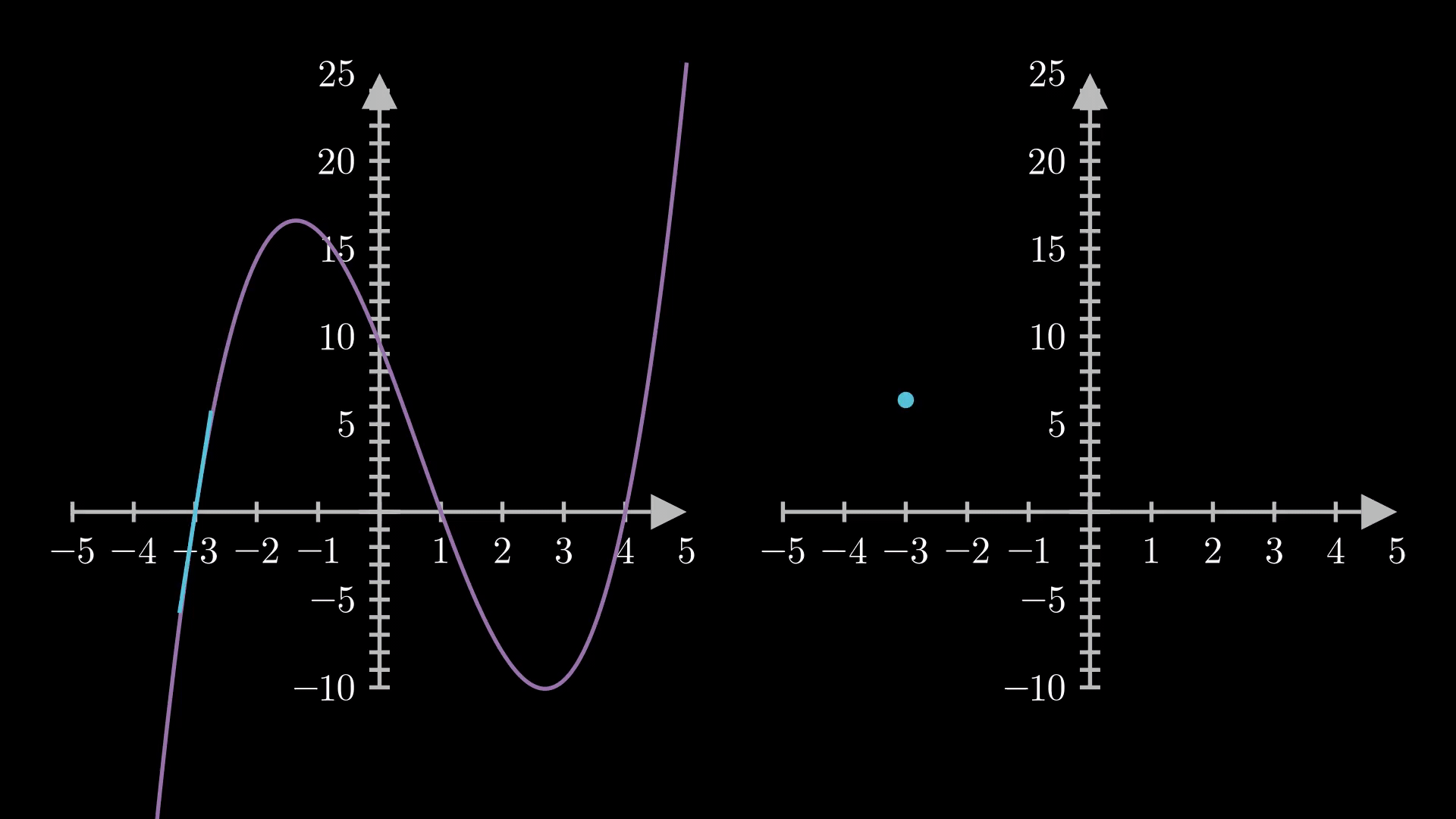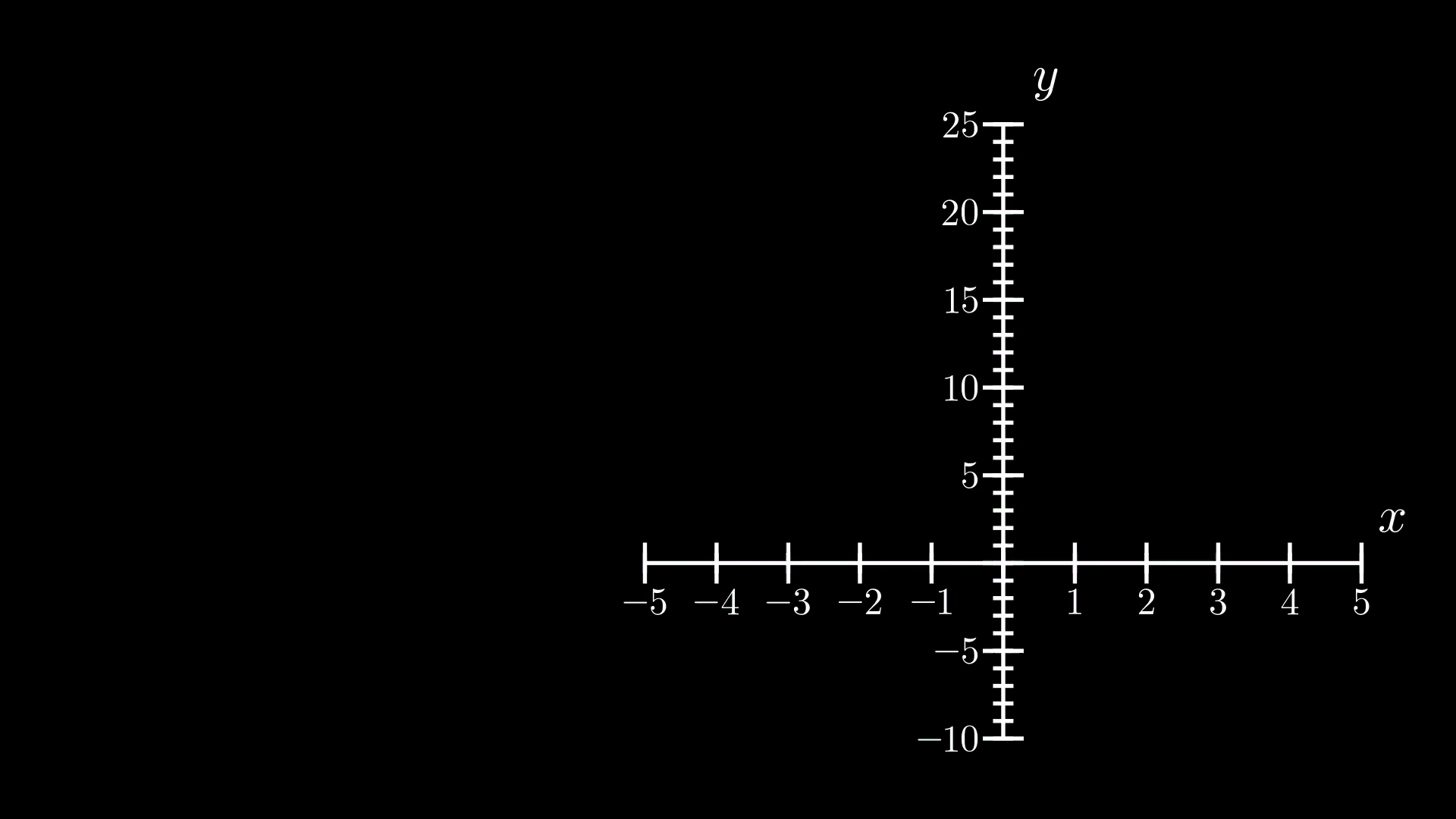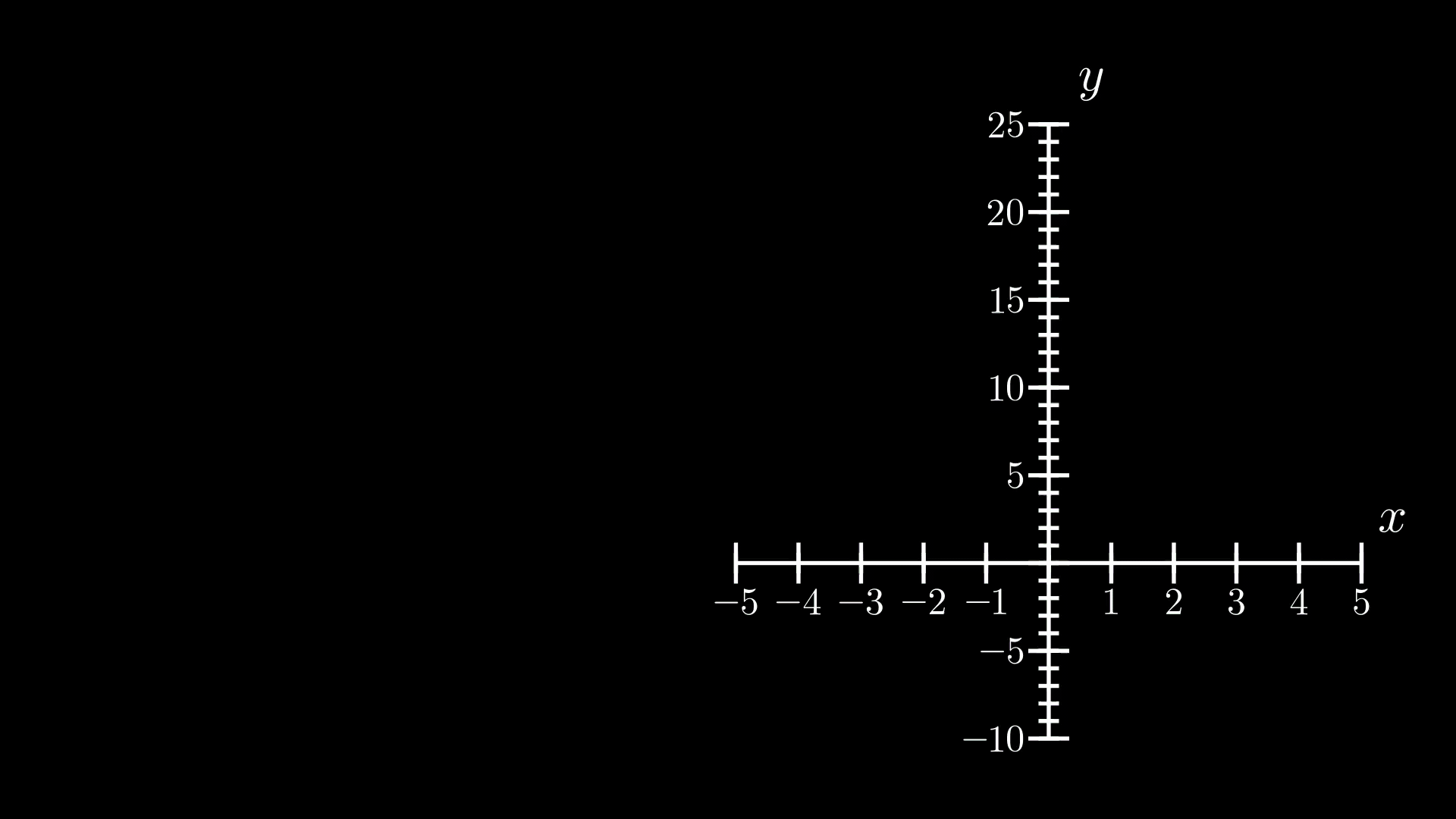Updaters will allow you to run a piece of code on each frame. Updater are executed after the animation.
from manim import *
class Example(Scene):
def construct(self):
square = Square()
square.shift(UP* (config["frame_y_radius"] - 2))
self.add(square)
child = Square().scale(0.5).next_to(square, RIGHT)
self.add(child)
## define updater first then give it an action
child.add_updater(lambda mob: mob.next_to(square,RIGHT))
self.play(square.animate.shift(DOWN * (config["frame_y_radius"] -2 )))# multiple updater
t = DecimalNumber()
t.add_updater(lambda mob: mob.next_to(square,RIGHT))
t.add_updater(lambda mob: mob.set_value(square.get_center()[1]))
Child object have same effect what parent object imposes
square.add(child)
self.play(square.animate.shift(DOWN * (config["frame_y_radius"] -2 )))class MoveAlongCurve(Scene):
def construct(self):
a = Axes()
self.add(a)
func = lambda x: (x+2)*(x+1)*(x-2)*(x-1)
g = a.get_graph(func)
self.add(g)
def move_along_curve(mob,dt):
new_x = mob.get_center()[0] + dt
mob.move_to(a.coords_to_point(new_x,func(new_x)))
d = Dot().move_to(a.coords_to_point(-2,func(-2)))
d.add_updater(move_along_curve)
self.add(d)
self.wait(4)## Another implement
v = ValueTracker(-2)
def move_along_curve(mob,dt):
mob.move_to(a.coords_to_point(v.get_value(),func(v.get_value())))
d = Dot().move_to(a.coords_to_point(-2,func(-2)))
d.add_updater(move_along_curve)
self.add(d)
self.play(v.animate.set_value(3),run_time=3)To make the curve smooth increase the run_time
class LissajousCurve(Scene):
def construct(self):
def lissajous_position(t):
A = 1
B = 1
a = 1
b = 1
delta = 1
x = A * np.sin(a*t + delta)
y = B * np.sin(b*t)
return np.array([x,y,0])
v = ValueTracker()
line = VMobject()
def update_dot(mob,dt):
## dt is cumulative hence use ValueTracker
new_position = lissajous_position(v.get_value())
d.move_to(new_position)
## each frame add
line.add_line_to(new_position)
d = Dot()
d.move_to(lissajous_position(0))
d.add_updater(update_dot)
self.add(d)
line.points = [d.get_center()]
self.add(line)
self.play(v.animate.set_value(10),rate_func=linear)
self.wait()class Derivative(GraphScene):
def __init__(self,**kwargs):
GraphScene.__init__(
self,
x_min=-1,
x_max=10,
y_min=-1,
y_max=6,
graph_origin=[-4,-2,0],
**kwargs
)
def construct(self):
self.setup_axes(animate=True)
func = lambda x : 0.1 * (x - 2) * (x - 8) * (x - 5) + 3
func_graph = self.get_graph(func,x_min=0.8,x_max=9)
x_start = 3
x_end = ValueTracker(7)
dot_start = Dot(self.coords_to_point(x_start,func(x_start)))
dot_end = Dot(self.coords_to_point(x_end.get_value(),func(x_end.get_value())))
def dot_updater(dot):
x = x_end.get_value()
dot.move_to(self.coords_to_point(x,func(x)))
dot_end.add_updater(dot_updater)
line = Line(dot_start.get_center(),dot_end.get_center())
line.add_updater(
lambda x : x.become(
Line(
dot_start.get_center(),dot_end.get_center()
)
)
)
self.play(Create(func_graph))
self.wait()
self.play(*list(map(GrowFromCenter,[dot_start,dot_end])))
self.wait()
self.play(Create(line))
self.wait()
self.play(x_end.animate.increment_value(-4),run_time=5)
self.wait()class DerivativeGraph(GraphScene):
def construct(self):
x_axis_numbers_to_show = list(range(-5,6,1))
x_axis_numbers_to_show.remove(0)
y_axis_numbers_to_show = list(range(-10,26,5))
y_axis_numbers_to_show.remove(0)
axes_config = dict(
x_axis_config = dict(
x_min = -5,
x_max = 5,
width = 6,
include_numbers = True,
numbers_to_show = x_axis_numbers_to_show
),
y_axis_config = dict(
x_min = -10, ## y_min/max didn't work
x_max = 25,
width = 6,
include_numbers = True,
numbers_to_show = y_axis_numbers_to_show
),
axes_config = dict(color=WHITE)
)
## add original graph
original = Axes(**axes_config)
original.to_edge(LEFT).shift(DOWN)
self.add(original)
func = lambda x: 0.8 * (x+3) * (x-1) * (x-4)
original_graph = original.get_graph(
func,
x_min = -5,
x_max = 5,
color = PURPLE
)
self.add(original_graph)
## add the derivative graph
derivative = Axes(**axes_config)
derivative.to_edge(RIGHT).shift(DOWN)
self.add(derivative)
tangent_tracker = ValueTracker(-3)
def get_tangent_angle(axes, func, x, dx):
difference_vector = axes.coords_to_point(
x+dx,func(x+dx)
) - axes.coords_to_point(x,func(x))
return angle_of_vector(difference_vector)
def update_tangent_line(mob):
x_location = tangent_tracker.get_value()
new_tangent = Line(LEFT,RIGHT).set_color(BLUE)
new_tangent.move_to(original.coords_to_point(x_location,func(x_location)))
new_tangent.rotate(get_tangent_angle(original,func,x_location,0.01))
mob.become(new_tangent)
## Move a tangent line across the original graph
tangent = Line(LEFT,RIGHT).set_color(BLUE)
# tracing things/ what happening
# self.play(tangent.animate.move_to(original.coords_to_point(-3,func(-3))))
# self.play(tangent.animate.rotate(get_tangent_angle(original,func,-3,0.01)))
## initial position of tangent line
tangent.move_to(original.coords_to_point(
tangent_tracker.get_value(),
func(tangent_tracker.get_value())
))
tangent.rotate(get_tangent_angle(original,func,tangent_tracker.get_value(),0.01))
tangent.add_updater(update_tangent_line)
self.add(tangent)
## Move a point across the derivative graph
derivative_path = VMobject().set_color(BLUE)
def get_slope(line):
start, end = line.get_start_and_end()
return (end[1] - start[1])/(end[0] - start[0])
def update_derivative_dot(mob):
mob.move_to(
derivative.coords_to_point(
tangent_tracker.get_value(),get_slope(tangent)
)
)
derivative_path.add_line_to(mob.get_center())
d = Dot().set_color(BLUE)
d.move_to(
derivative.coords_to_point(
tangent_tracker.get_value(),get_slope(tangent)
)
)
d.add_updater(update_derivative_dot)
self.add(d)
derivative_path.points = np.array([d.get_center()])
self.add(derivative_path)
self.play(tangent_tracker.animate.set_value(5),rate_func=linear,run_time=5)
self.wait()
self.play(tangent_tracker.animate.set_value(-4),rate_func=linear,run_time=5)
## rate_func= there_and_back_with_pause
self.wait()axes_config = dict(
x_axis_config = dict(
x_min = -5,
x_max = 5,
width = 6,
include_numbers = True,
numbers_to_show = list(range(-5,6,1))
),
y_axis_config = dict(
x_min = -10, ## y_min/max didn't work
x_max = 25,
width = 6,
include_numbers = True,
numbers_to_show = list(range(-10,26,5))
),
axes_config = dict(color=WHITE)
)
class IntegralGraph(GraphScene):
def construct(self):
self.x_min = -5
self.x_max = 5
self.y_min = -10
self.y_max = 25
self.x_axis_width = config.frame_width / 2 - 1
self.y_axis_height = 6
self.axes_color = WHITE
self.graph_origin = DOWN * 2
self.x_axis_label = "$x$"
self.y_axis_label = "$y$"
self.x_labeled_nums = list(range(-5,6,1))
self.y_labeled_nums = list(range(-10,26,5))
self.setup_axes()
self.axes.to_edge(RIGHT).shift(UP*0.5)
func = lambda x: 0.8 * (x+3) * (x-1) * (x-4)
original_graph = self.get_graph(
func,
x_min = -5,
x_max = 5,
color = PURPLE
)
self.play(Create(original_graph))
riemann_tracker = ValueTracker(-4)
dx = 0.04
area = self.get_riemann_rectangles(
original_graph,
dx=dx,
x_min=-4,
x_max=riemann_tracker.get_value(),
input_sample_type = "center",
stroke_width = 0
)
area.value = 0
def update_area(mob):
new_area = self.get_riemann_rectangles(
original_graph,
dx=dx,
x_min=-4,
x_max=riemann_tracker.get_value(),
input_sample_type = "center",
stroke_width = 0
)
mob.become(new_area)
new_value = 0
x_val = -4
for rect in new_area.submobjects:
x_val += dx
if func(x_val)<0:
new_value -= rect.get_height() * dx
else:
new_value += rect.get_height() * dx
mob.value = new_value
area.add_updater(update_area)
self.add(area)
## Add integral graph
integral = (
Axes(**axes_config)
.to_edge(LEFT)
.align_to(self.axes,DOWN)
.shift(DOWN * 0.1)
)
self.add(integral)
integral_path = VMobject().set_color(GREEN)
def update_integral_dot(mob):
integral_graph_location = np.array(
integral.coords_to_point(riemann_tracker.get_value(),area.value)
)
mob.move_to(integral_graph_location)
integral_path.add_line_to(mob.get_center())
integral_graph_location = np.array(
[self.x_axis.n2p(riemann_tracker.get_value())[0],
self.y_axis.n2p(0)[1],
0]
)
d = (Dot().set_color(GREEN).move_to(integral.coords_to_point(
riemann_tracker.get_value(),area.value
)))
integral_path.points = np.array([d.get_center()])
self.add(integral_path)
d.add_updater(update_integral_dot)
self.add(d)
self.play(riemann_tracker.animate.set_value(5),rate_func=linear,run_time=3)
self.wait()